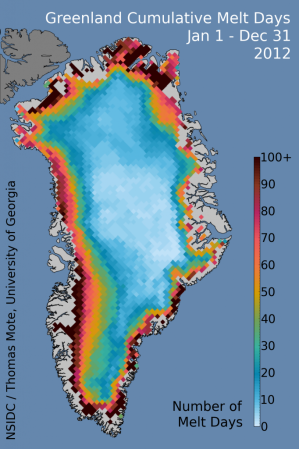Melting of Greenland's 'fringe' glaciers adds to sea level rise
 Glaciers on the edge of Greenland are pouring at about 50 gigatons of water into the Atlantic every year. That’s about half the volume of Lake Geneva, one of Europe’s largest lake, and enough to account for about 10 percent of annual global sea level rise, according to a new study by Swiss and Danish scientists.
Glaciers on the edge of Greenland are pouring at about 50 gigatons of water into the Atlantic every year. That’s about half the volume of Lake Geneva, one of Europe’s largest lake, and enough to account for about 10 percent of annual global sea level rise, according to a new study by Swiss and Danish scientists.The research, published in Geophysical Research Letters, will help scientists improve the predictions of the future contribution of Greenland’s ice to sea-level rise.
The data could also be used by researchers maintaining the new Greenland Today website, which tracks the state of the ice cap on a real-time basis.
“The melting of ice on Greenland is known to be one of the major sources for global sea-level rise. Beside the large ice sheet, there are thousands of peripheral glaciers which are not connected to the ice sheet or can be separated from it due to the existence of ice divides,” said lead author Dr. Tobias Bolch, of the University of Zurich. “The area of those glaciers is about 50 times higher than the ice cover of the European Alps. Consequently, it is important to investigate not only the ice sheet but also these local glaciers,” he said.
“The new figure for the local glaciers is higher than expected,” Bolch said. “It matters because the ice loss with respect to the area is significantly higher than of the ice sheet. This means that the local glaciers react faster with respect to climate change. This information will help to improve the predictions of the future contribution of Greenland’s ice to sea-level rise.”
Using lasers to measure the height of the ice from space, as well as data from recently completed inventory of Greenland’s glaciers and ice caps helped measure changes in the mass of the fringe glaciers, and to estimate the total amount of water at about 30 gigatons.
When the models added in glaciers which had some link to the ice sheet, but which were still distinct from it in the way they flowed, the amount of water figure increased to about 50 Gt per year. This yearly figure represents more than half the water contained in one of Europe’s largest lakes, Lake Geneva.
The study gives more detail to the make-up and stability of Greenland’s glaciers showing that mass loss is highest in the warmer south east of the land mass and lowest in the colder north. It also shows that the loss of ice is about 2.5 times higher for those separate glaciers than for the ice sheet.
You can return to the main Market News page, or press the Back button on your browser.

